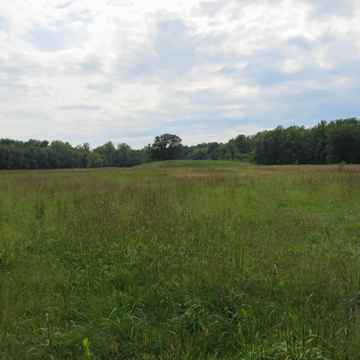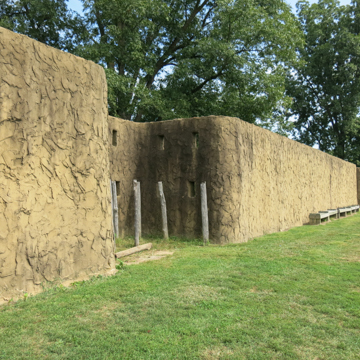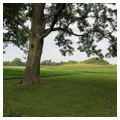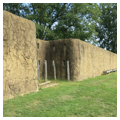You are here
Angel Mounds
Angel Mounds is an archaeological site in Southwest Indiana that represents the Mississippian culture during the late prehistoric period. It is one of the best-preserved Native American sites in the United States. The fortified community was likely an important regional center that supported a large population and was the largest settlement in Indiana at its height.
The Mississippian culture thrived throughout the southeastern United States and as far north as Indiana and Illinois. Mississippians were sedentary agriculturalists who supplemented farming with hunting and gathering. The Angel Mounds site, named for the farming family who owned the property in the early twentieth century, was likely the northeastern most corner of the culture’s reach and served the surrounding communities within a 70-mile radius. The town plan was smaller than, but otherwise similar to, Cahokia in East Saint Louis, the culture’s largest city.
Archaeological evidence suggests that Angel Mounds was settled as early as 1000 CE. Its location along the Ohio River was ideal; spring floods fertilized the land, allowing the community to grow enough crops to support the local population. The surrounding hills offered a safe haven in times of great flooding. Three Mile Island, located in the Ohio River just south of the site, divided the river and created a calm channel of the mighty Ohio. A slough around the site provided a level of protection from invaders.
Current research suggests that Angel Mounds was a regional social, political, and religious center. The site included at least eleven earthenwork mounds, a town plaza, and a temple. The entire community was elevated on a terrace, surrounded by a 12-foot-tall stockade of wattle and daub. At least 200 houses have been located, possibly supporting a population of around 1,000 people. The houses were either square or rectangular, about 400 square feet in size, and also constructed of wattle and daub. The single open space of each house had a central hearth with benches along the interior walls.
Archaeological digs have located large amounts of pottery, both utilitarian and decorative. Goods imported from other regions of what is now the United States have also been discovered, suggesting that the community grew sufficient surplus crops to participate in trade. Imported items discovered include copper from the Upper Great Lakes region, flint from Tennessee, and shells originating from the Gulf of Mexico.
The site includes at least five large platform mounds and seven smaller ones arranged around two plazas. The exact functions of the mounds are unknown, but may have served ceremonial and cosmological purposes, elevated important buildings, or provided living space for the upper classes. Central Mound is the tallest. With two levels rising a total of 44 feet, it is the 10th largest Native American mound known to exist in the United States. Archaeological evidence suggests that a log staircase ascended to the summit. The mound was constructed with several different types of soil to add structural stability.
The site was abandoned by 1450 for unknown reasons. Droughts may have made farming difficult or other resources, including deer, may have been depleted. The population moved towards the confluence of the Ohio and Wabash rivers by 1450, and vanished by 1650. Several other Native American tribes moved through the area shortly after the Mississippians left, but the exact fate of their culture is unknown.
Angel Mounds has been known to archaeologists since the nineteenth century. The Indiana Historical Society purchased 421 acres around the prehistoric town in 1938 and donated the entire site to the State of Indiana in 1946. Archaeologist Glenn Black began the first scientific studies of Angel Mounds in 1938 as part of a joint project between the Indiana Historical Society and the Works Progress Administration. Designated a National Historic Landmark in 1964, the site continues to be studied today and has revealed a great deal of information about the Mississippian culture. The site is open to visitors, who can tour the existing mounds, part of a reconstructed town, and a modern museum that interprets the Mississippian people.
References
“Angel Mounds.” Indiana State Museum and Historic Sites. Accessed June 28, 2016. www.indianamuseum.org.
Krus, Anthony Michal, Timothy Schilling, and G. William Monaghan. “The Time of Angel Mounds Palisade Construction: a search for the best chronological model.” Midcontinental Journal of Archaeology38, no. 2 (September 2013).
Monaghan, G. William, et al. “Mound Construction Chronology at Angel Mounds: episodic mound construction and ceremonial events.” Midcontinental Journal of Archaeology38, no. 2 (September 2013).
Writing Credits
If SAH Archipedia has been useful to you, please consider supporting it.
SAH Archipedia tells the story of the United States through its buildings, landscapes, and cities. This freely available resource empowers the public with authoritative knowledge that deepens their understanding and appreciation of the built environment. But the Society of Architectural Historians, which created SAH Archipedia with University of Virginia Press, needs your support to maintain the high-caliber research, writing, photography, cartography, editing, design, and programming that make SAH Archipedia a trusted online resource available to all who value the history of place, heritage tourism, and learning.



















